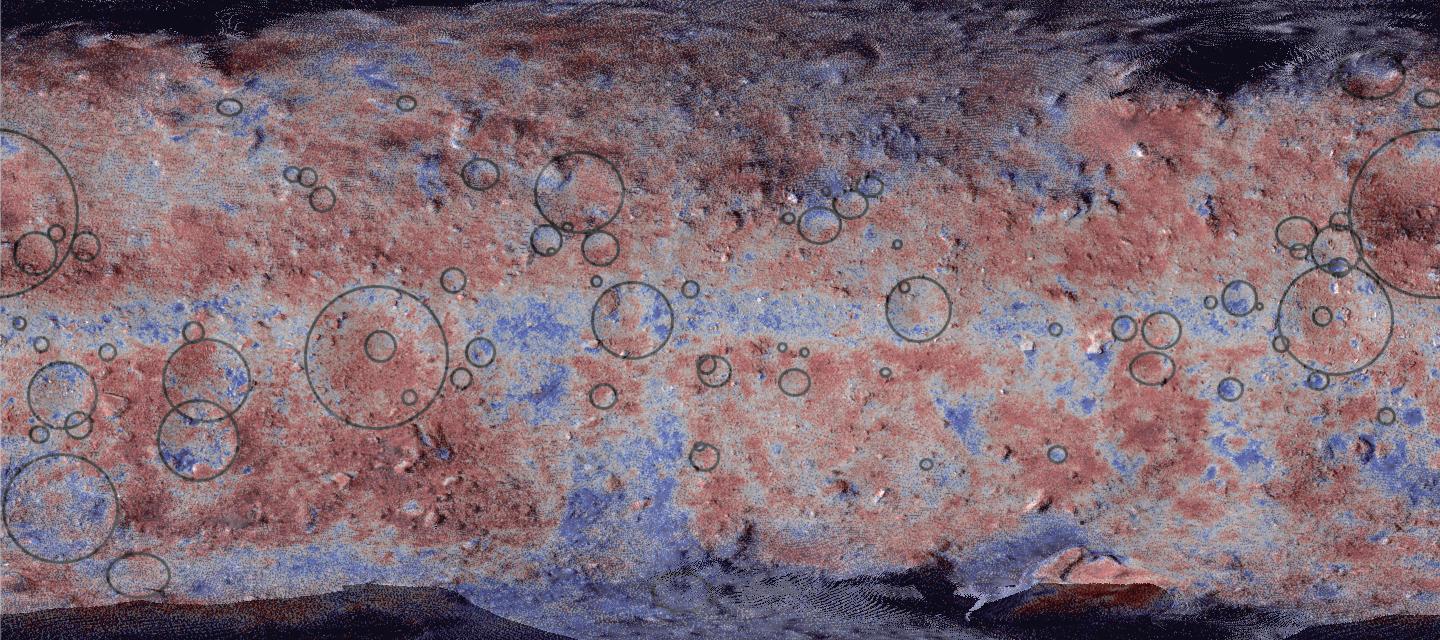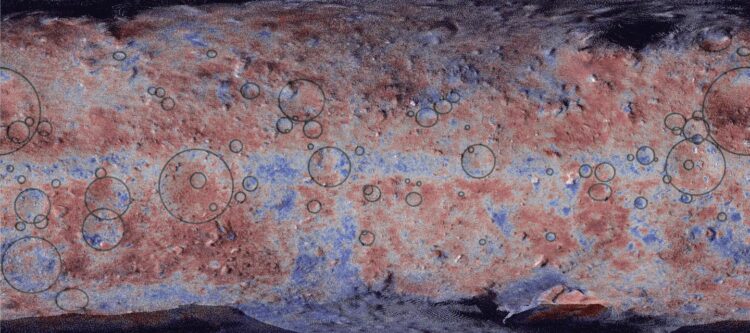Ryugu’s interaction with the sun changes what we know about asteroid history

Credit: © 2020 Morota et al.
In February and July of 2019, the Hayabusa2 spacecraft briefly touched down on the surface of near-Earth asteroid Ryugu. The readings it took with various instruments at those times have given researchers insight into the physical and chemical properties of the 1-kilometer-wide asteroid. These findings could help explain the history of Ryugu and other asteroids, as well as the solar system at large.
When our solar system formed around 5 billion years ago, most of the material it formed from became the sun, and a fraction of a percent became the planets and solid bodies, including asteroids. Planets have changed a lot since the early days of the solar system due to geological processes, chemical changes, bombardments and more. But asteroids have remained more or less the same as they are too small to experience those things, and are therefore useful for researchers who investigate the early solar system and our origins.
“I believe knowledge of the evolutionary processes of asteroids and planets are essential to understand the origins of the Earth and life itself,” said Associate Professor Tomokatsu Morota from the Department of Earth and Planetary Science at the University of Tokyo. “Asteroid Ryugu presents an amazing opportunity to learn more about this as it is relatively close to home, so Hayabusa2 could make a return journey relatively easily. “
Hayabusa2 launched in December 2014 and reached Ryugu in June 2018. At the time of writing, Hayabusa2 is on its way back to Earth and is scheduled to deliver a payload in December 2020. This payload consists of small samples of surface material from Ryugu collected during two touchdowns in February and July of 2019. Researchers will learn much from the direct study of this material, but even before it reaches us, Hayabusa2 helped researchers to investigate the physical and chemical makeup of Ryugu.
“We used Hayabusa2’s ONC-W1 and ONC-T imaging instruments to look at dusty matter kicked up by the spacecraft’s engines during the touchdowns,” said Morota. “We discovered large amounts of very fine grains of dark-red colored minerals. These were produced by solar heating, suggesting at some point Ryugu must have passed close by the sun.”
Morota and his team investigated the spatial distribution of the dark-red matter around Ryugu as well as its spectra or light signature. The strong presence of the material around specific latitudes corresponded to the areas that would have received the most solar radiation in the asteroid’s past; hence, the belief that Ryugu must have passed by the sun.
“From previous studies we know Ryugu is carbon-rich and contains hydrated minerals and organic molecules. We wanted to know how solar heating chemically changed these molecules,” said Morota. “Our theories about solar heating could change what we know of orbital dynamics of asteroids in the solar system. This in turn alters our knowledge of broader solar system history, including factors that may have affected the early Earth.”
When Hayabusa2 delivers material it collected during both touchdowns, researchers will unlock even more secrets of our solar history. Based on spectral readings and albedo, or reflectivity, from within the touchdown sites, researchers are confident that both dark-red solar-heated material and gray unheated material were collected by Hayabusa2. Morota and his team hope to study larger properties of Ryugu, such as its many craters and boulders.
“I wish to study the statistics of Ryugu’s surface craters to better understand the strength characteristics of its rocks, and history of small impacts it may have received,” said Morota. “The craters and boulders on Ryugu meant there were limited safe landing locations for Hayabusa2. Finding a suitable location was hard work and the eventual first successful touchdown was one of the most exciting events of my life.”
###
Journal article
T. Morota, S. Sugita, Y. Cho, M. Kanamaru, E. Tatsumi, N. Sakatani, R. Honda, N. Hirata, H. Kikuchi, M. Yamada, Y. Yokota, S. Kameda, M. Matsuoka, H. Sawada, C. Honda, T. Kouyama, K. Ogawa, H. Suzuki, K. Yoshioka, M. Hayakawa, N. Hirata, M. Hirabayashi, H. Miyamoto, T. Michikami, T. Hiroi, R. Hemmi, O. S. Barnouin, C. M. Ernst, K. Kitazato, T. Nakamura, L. Riu, H. Senshu, H. Kobayashi, S. Sasaki, G. Komatsu, N. Tanabe, Y. Fujii, T. Irie, M. Suemitsu, N. Takaki, C. Sugimoto, K. Yumoto, M. Ishida, H. Kato, K. Moroi, D. Domingue, P. Michel, C. Pilorget, T. Iwata, M. Abe, M. Ohtake, Y. Nakauchi, K. Tsumura, H. Yabuta, Y. Ishihara, R. Noguchi, K. Matsumoto, A. Miura, N. Namiki, S. Tachibana, M. Arakawa, H. Ikeda, K. Wada, T. Mizuno, C. Hirose, S. Hosoda, O. Mori, T. Shimada, S. Soldini, R. Tsukizaki, H. Yano, M. Ozaki, H. Takeuchi, Y. Yamamoto, T. Okada, Y. Shimaki, K. Shirai, Y. Iijima, H. Noda, S. Kikuchi, T. Yamaguchi, N. Ogawa, G. Ono, Y. Mimasu, K. Yoshikawa, T. Takahashi, Y. Takei, A. Fujii, S. Nakazawa, F. Terui, S. Tanaka, M. Yoshikawa, T. Saiki, S. Watanabe and Y. Tsuda. Sample collection from asteroid 162173 Ryugu by Hayabusa2: Implications for surface evolution. Science. DOI: 10.1126/science.aaz6306
Funding and support
Japan Society for the Promotion of Science (JSPS) KAKENHI (Grant Nos. 17H06459, 19H01951, 17H01175, 17KK0097, 19H00727, 18H01267, 18K11610, 19K03955, 16H04044, 19K03958). JSPS Core-to-Core program “International Network of Planetary Sciences.” NASA EW and PDART programs. NASA/Solar System Workings (NNH17ZDA001N/80NSSC19K0548) and Auburn University’s intramural research grant. OSIRIS-REx under Contract NNM10AA11C issued through the NASA New Frontiers Program. NASA Hayabusa2 Participating Scientist Program. French space agency CNES and Academies of Excellence: Complex systems and Space, environment, risk, and resilience, part of the IDEX JEDI of the Université Côte d’Azur. European Union’s Horizon 2020 research and innovation program under grant agreement No. 870377 (project NEO-MAPP).
Useful links
Previous research on Ryugu
https:/
Department of Earth and Planetary Science
http://www.
Graduate School of Science
https:/
Research contact
Associate Professor Tomokatsu Morota
Department of Earth and Planetary Science, The University of Tokyo,
7-3-1 Hongo, Bunkyo-ku, 113-0033 Tokyo, Japan
Tel: +81-(0)70-3179-8040
Email: [email protected]
Press Contact
Mr. Rohan Mehra
Division for Strategic Public Relations, The University of Tokyo
7-3-1 Hongo, Bunkyo-ku, Tokyo 113-8654, JAPAN
Tel: +81-(0)80-9707-8450
Email: [email protected]
About the University of Tokyo
The University of Tokyo is Japan’s leading university and one of the world’s top research universities. The vast research output of some 6,000 researchers is published in the world’s top journals across the arts and sciences. Our vibrant student body of around 15,000 undergraduate and 15,000 graduate students includes over 4,000 international students. Find out more at http://www.
Media Contact
Tomokatsu Morota
[email protected]
Original Source
https:/
Related Journal Article
http://dx.





